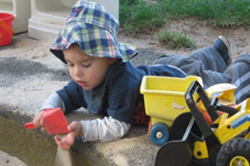First research to successfully predict the responses of children with autism to treatment models

Research Fellow Dr Giacomo Vivanti and his team of researchers at the Olga Tennison Autism Research Centre (OTARC) at La Trobe University have successfully profiled children with autism in order to predict how well they will respond to a particular form of developmental therapy.
 Dr Cheryl Dissanayake, Director of OTARC, says that Dr Vivanti¹s research, published last week in the Journal of Autism and Development Disorders, is the first of its kind to profile children in order to predict treatment responses.
Dr Cheryl Dissanayake, Director of OTARC, says that Dr Vivanti¹s research, published last week in the Journal of Autism and Development Disorders, is the first of its kind to profile children in order to predict treatment responses.
This research is important because it is the first step towards being able to identify which intervention programs are best suited to specific children, says Dr Dissanayake.
The autism intervention model being studied by Dr Vivanti and his team is the Early Start Denver Model (ESDM), which is being implemented at the Victorian Autism Specific Early Learning and Care Centre: The Margot Prior Wing of the La Trobe Community Childrens Centre since 2010. (See details of the ESDM, below.)
There is little doubt that all children in the Margot Prior Wing benefit from the ESDM, but what we’re trying to understand is why some children make more gains than others.
ŒChildren are making gains across four cognitive areas after one year of therapy. And some children in our sample are moving from a severe autism diagnosis to a less severe diagnosis.
However, not all children improve to the same degree under the ESDM, and Dr Vivanti says that the challenge is to better understand how to match children to the programs that are best suited to their specific needs.
We are working on the issue of what works for whom and why? says Dr Vivanti. The paper published this week details the initial results of the OTARC research, and uses the profiling model developed by Dr Vivanti to predict the responses of children at the Margot Prior Wing to the ESDM therapy.
The paper shows that Dr Vivantis profiling model has been highly successful in predicting treatment outcomes for children undergoing the ESDM intervention, although the sample size was relatively small, with 21 children participating in the study.
The next step in the research, says Dr Dissanayake, is to assess whether the predictors of treatment success used by Dr Vivanti will work equally well when used in other types of early intervention programs.
We really want to get to the stage where we can say, this group of children will do better in program A, whereas these other children will do better in program B so that we can prospectively match treatments to individual children, says Dr Dissanayake.
REPORT: Autism intervention model normalises brain signals in children with autism
An American study provides strong evidence for the effectiveness of an autism intervention model known as the Early Start Denver Model (ESDM), currently in use at the Margot Prior Wing of La Trobe Childrens Centre.
It’s been known for some time that ESDM leads to significant positive changes in the development of children with autism, says Dr Cheryl Dissanayake, Director of the Olga Tennison Autism Research Centre (OTARC) at La Trobe.
The latest American research builds on this by demonstrating that ESDM may actually normalise brain signals of young children receiving the therapy in terms of the way that they respond to faces and objects.
What this means is that children receiving ESDM showed the same pattern of response to faces and objects as typically developing kids. They are still autistic, but the ESDM seems to be changing the way their brain responds to other people.
Ultimately, this means that they will relate to other people in a more normal manner, says Dr Dissanayake.
The ESDM has been in use at the Victorian Autism Specific Early Learning and Care Centre: The Margot Prior Wing of the La Trobe Community Children’s Centre since 2010. The model in its original form relies on one-on-one delivery, but the Margot Prior Wing has adapted the model for delivery in a group setting.
The ESDM is a developmentally-based behavioural intervention model for children between 12 and 60 months of age. It is a naturalistic play-based approach delivered by specially trained therapists in collaboration with the childs parents or guardians. The therapy is based on strict adherence to a manual that guides treatment.
The American research, published last week in the Journal of the American Academy of Child and Adolescent Psychiatry, provides further evidence in support of the ESDM.
The La Trobe University centre is one of six Autism Specific Early Learning and Care Centres funded by the Federal Government, and one of just two centres that deliver a group-based ESDM. Research is currently taking place at the Margot Prior Wing to assess the effectiveness of the ESDM in a group setting, as well as to understand why some children make greater gains in response to the ESDM than others.
 Follow
Follow